
Publius Licinius Egnatius Gallienus was Roman emperor with his father Valerian from 253 to 260 and alone from 260 to 268. He ruled during the Crisis of the Third Century that nearly caused the collapse of the empire. He won numerous military victories against usurpers and Germanic tribes, but was unable to prevent the secession of important provinces. His 15-year reign was the longest in half a century.
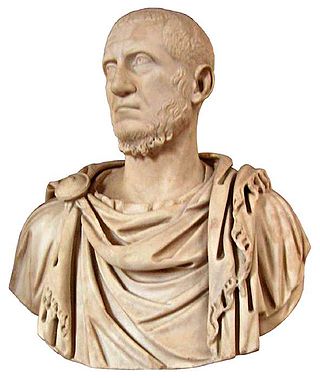
Marcus Claudius Tacitus was Roman emperor from 275 to 276. During his short reign he campaigned against the Goths and the Heruli, for which he received the title Gothicus Maximus.
The 260s decade ran from January 1, 260, to December 31, 269.

Septimia Zenobia was a third-century queen of the Palmyrene Empire in Syria. Many legends surround her ancestry; she was probably not a commoner and she married the ruler of the city, Odaenathus. Her husband became king in 260, elevating Palmyra to supreme power in the Near East by defeating the Sasanian Empire of Persia and stabilizing the Roman East. After Odaenathus' assassination, Zenobia became the regent of her son Vaballathus and held de facto power throughout his reign.

Aurelian was a Roman emperor, who reigned during the Crisis of the Third Century, from 270 to 275. As emperor, he won an unprecedented series of military victories which reunited the Roman Empire after it had nearly disintegrated under the pressure of barbarian invasions and internal revolts. Born in modest circumstances, most likely in Moesia Superior, he entered the Roman army in 235 and climbed up the ranks. He went on to lead the cavalry of the emperor Gallienus, until Gallienus' assassination in 268. Following that, Claudius Gothicus became emperor until his own death in 270. Claudius' brother Quintillus ruled the empire for three months, before Aurelian became emperor.
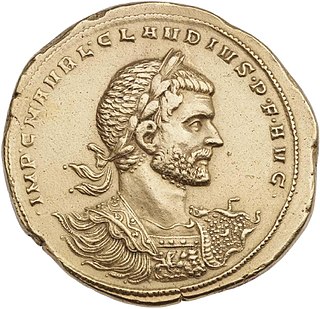
Marcus Aurelius Claudius "Gothicus", also known as Claudius II, was Roman emperor from 268 to 270. During his reign he fought successfully against the Alemanni and decisively defeated the Goths at the Battle of Naissus. He died after succumbing to a "pestilence", possibly the Plague of Cyprian that had ravaged the provinces of the Empire.
The Battle of Naissus was the defeat of a Gothic coalition by the Roman Empire under Emperor Gallienus and the future Emperor Aurelian near Naissus. The events around the invasion and the battle are an important part of the history of the Crisis of the Third Century.
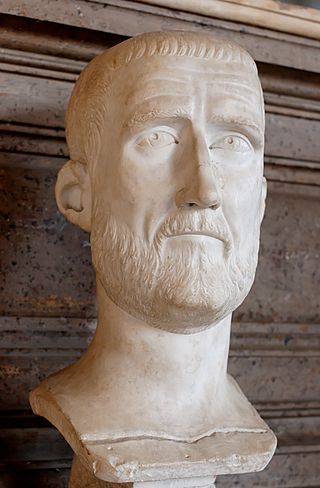
Marcus Aurelius Probus was Roman emperor from 276 to 282. Probus was an active and successful general as well as a conscientious administrator, and in his reign of six years he secured prosperity for the inner provinces while withstanding repeated invasions of barbarian tribes on almost every sector of the frontier.

Marcus Cassianius Latinius Postumus was a Roman commander of Batavian origin, who ruled as emperor of the splinter state of the Roman Empire known to modern historians as the Gallic Empire. The Roman army in Gaul threw off its allegiance to Gallienus around the year 260, and Postumus assumed the title and powers of Emperor in the provinces of Gaul, Germania, Britannia, and Hispania. He ruled for the better part of ten years before he was murdered by his own troops.

Gaius Pius Esuvius Tetricus was the emperor of the Gallic Empire from 271 to 274 AD. He was originally the praeses (governor) of Gallia Aquitania and became emperor after the murder of Emperor Victorinus in 271, with the support of Victorinus's mother, Victoria. During his reign, he faced external pressure from Germanic raiders, who pillaged the eastern and northern parts of his empire, and the Roman Empire, from which the Gallic Empire had seceded. He also faced increasing internal pressure, which led him to declare his son, Tetricus II, caesar in 273 and possibly co-emperor in 274, although this is debated. The Roman emperor Aurelian invaded in 273 or 274, leading to the Battle of Châlons, at which Tetricus surrendered. Whether this capitulation was the result of a secret agreement between Tetricus and Aurelian or necessary after his defeat is debated. Aurelian spared Tetricus, and even made him a senator and corrector (governor) of Lucania et Bruttium. Tetricus died of natural causes a few years after 274.
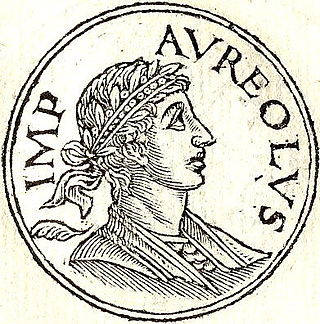
Aureolus was a Roman military commander during the reign of Emperor Gallienus before he attempted to usurp the Roman Empire. After turning against Gallienus, Aureolus was killed during the political turmoil that surrounded the Emperor's assassination in a conspiracy orchestrated by his senior officers. Aureolus is known as one of the Thirty Tyrants and is referenced in ancient sources including the Historia Augusta, Zonaras' epitome and Zosimus' Historia Nova.
Balista or Ballista, also known in the sources with the name of "Callistus", was one of the Thirty Tyrants of the controversial Historia Augusta, and supported the rebellion of the Macriani against Emperor Gallienus.
The Gallienus usurpers were the usurpers who claimed imperial power during the reign of Gallienus. The existence of usurpers during the Crisis of the Third Century was very common, and the high number of usurpers fought by Gallienus is due to his long rule; fifteen years being considered long by the standards of the 3rd century Roman Empire.
Lucius Petronius Taurus Volusianus was a Roman citizen, apparently of equestrian origins, whose career in the Imperial Service in the mid-Third Century AD carried him from a relatively modest station in life to the highest public offices and senatorial status in a very few years. He may have secured his first appointments before the Licinian Dynasty – – acceded to the Empire in 253 AD, but it was in the course of their reign that his upward progress achieved an almost unprecedented momentum and the second factor seems to have been a consequence of the first. The nature of his relationship to the Licinii is uncertain, but it seems likely that a common origin in the Etruscan region of central Italy at least predisposed Gallienus in his favour and he seems to have been that emperor's most trusted servant and adviser during the period of his sole reign - 260(?)-268 AD.
Julius Placidianus was a Roman general of the 3rd century. He was a professional soldier who advanced his career under Gallienus and survived into the age of Claudius II and Aurelian. Placidianus was consul in the year 273 as the posterior colleague of Marcus Claudius Tacitus, the future emperor. His life presented here is largely derived from L.L. Howe's history of the Praetorian Prefecture.
Successianus was a Roman soldier, general and praetorian prefect in the third century AD of whom very little is known for certain. He is said to have distinguished himself as commander of the garrison of an allied city besieged by barbarian pirates, and then made praetorian prefect by the emperor Valerian on the strength of this. As praetorian prefect appears to have done useful work in restoring Antioch, the capital of the Roman East, after the devastation which had been inflicted by Shapur, the King of the Persians, in his invasion of 252. However, he was overwhelmed by the circumstances with which he had to contend when Shapur invaded on a second occasion in 260 and seems to have shared in the defeat of Valerian at the Battle of Edessa and his subsequent captivity in Persia.
Aurelius/Iulius Marcellinus was a Roman soldier and Imperial functionary who had a brilliant equestrian career and was elevated to the Senate when he was chosen by the Emperor Aurelian as his consular colleague. His appointment as Consul is thought to have been a reward for his loyalty and steadfastness in 273 when, as Aurelian's deputy in charge of the eastern provinces of the Empire where the authority of the Imperial Government had only recently been restored, he resisted attempts to suborn him by a rebellious faction in the city of Palmyra.
Traianus Mucianus was a Roman soldier of Thracian origins of the second half of the Third Century AD who rose from the lowest ranks of the army to senior commands. He was almost certainly a remarkable soldier. However, the successive promotions he secured in the latter part of his career are thought to owe much also to the favour shown him by men highly placed in the Imperial entourage whose patronage secured him advantageous postings in the Imperial comitatus, the mobile field force under the direct command of the Emperor, that was undergoing massive expansion at this time.
Lucius Aurelius Marcianus was a Roman soldier whose military career coincided with the period of crisis that characterized the middle decades of the Third Century AD – see Crisis of the Third Century. Probably of humble origins in one of the Illyrician provinces of the Empire he was one of the group of men from this region who chose a military career – or had it chosen for them – whose professional capabilities brought them to the fore of public life in those troubled times. Marcianus rose to the highest levels of the military hierarchy. The evidence suggests that he earned the trust of the Emperors Gallienus and Claudius II and, possibly, Marcus Aurelius Probus among their successors and that he was one of the principal commanders in the prolonged war against a coalition of what the late antique Greek writers called Scythian peoples whose incursions in that period seemed to threaten the very survival of the Roman state. These would refer to the major Germanic and Iranian peoples, among them the Goths and Roxolani, who invaded the Roman empire across the lower Danube River.
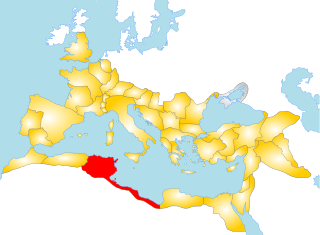
Tenagino Probus was a Roman soldier and procuratorial official whose career reached its peak at the end of the sixth decade of the third century AD. A poverty of primary sources means that nothing is known for certain of his origins or early career. However, in later years he served successively as Praeses (governor) of the province of Numidia and of Egypt,. These were both very senior procuratorial offices, the latter in particular traditionally considered one of the pinnacles of an equestrian career. In these roles he exercised military skills in addition to administrative ones; as Praefectus Aegypti he led military operations outside his province. He died resisting the invasion of Egypt by the forces of Zenobia of Palmyra in the troubled interregnum between Emperors Claudius II and Aurelian.